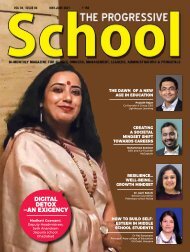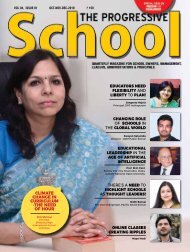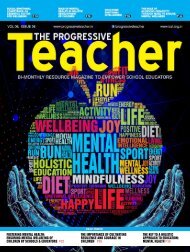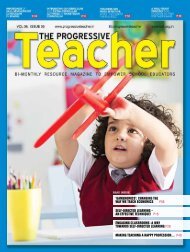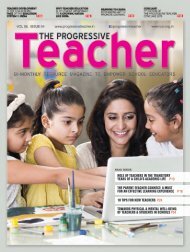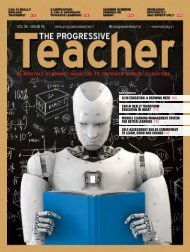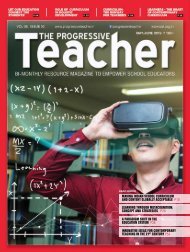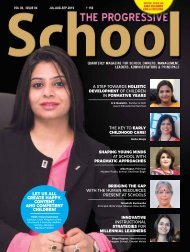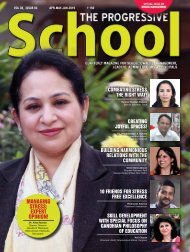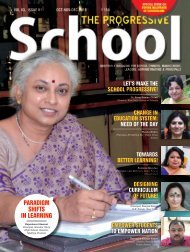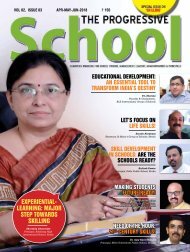The Progressive Teacher Vol 03 Issue 05
This issue of The Progressive Teacher focuses on "Teaching of Social Studies". The magazine provides guidance to the teachers by their peers and school leaders for tackling challenges with innovative ideas.
This issue of The Progressive Teacher focuses on "Teaching of Social Studies". The magazine provides guidance to the teachers by their peers and school leaders for tackling challenges with innovative ideas.
Create successful ePaper yourself
Turn your PDF publications into a flip-book with our unique Google optimized e-Paper software.
arts education<br />
Arts At Work<br />
In Education<br />
–P. Ajitha<br />
Imagine a world devoid of creativity, imagination and artistic<br />
expression! It alludes to a world without the arts. A cursory<br />
glance at the definitions of arts thrown up by google search<br />
provides n number of answers.<br />
<strong>The</strong> most basic and simple one is<br />
provided by the Oxford dictionary -‘Art<br />
is a diverse range of human activities<br />
in creating visual, auditory or performing<br />
artefacts (artworks), expressing the author’s<br />
imaginative or technical skill, intended to be<br />
appreciated for their beauty or emotional<br />
powers.’ <strong>The</strong> Merriam-Webster’s dictionary<br />
defines art as ‘something that is created with<br />
imagination and skill and that is beautiful or<br />
that expresses important ideas or feelings’.<br />
Thus arts ‘are a physical manifestation of the<br />
internal creative impulse’. <strong>The</strong>se definitions<br />
would suffice to realize why arts should be a<br />
part of every educational enterprise. Pablo<br />
Picasso once famously asserted ‘Every child<br />
is an artist. <strong>The</strong> problem is how to remain<br />
an artist once we grow up’. Thanks to the<br />
increased awareness and realization that a<br />
close encounter with the arts for school<br />
children to learn, explore and experiment in<br />
order to or as a means of creatively engaging<br />
with the world we live in, play a vital role in<br />
their development. Some educationists have<br />
woken up to the need for promoting a robust<br />
art curriculum alongside a rigorous academic<br />
discipline because an immersive engagement<br />
with the arts can be a transformational<br />
experience for young and impressionable<br />
minds. <strong>The</strong> arts include both performing arts<br />
– among them music, dance, and theatre, and<br />
visual arts – including drawing, painting and<br />
sculpting - things that are ‘taught’ in schools.<br />
<strong>The</strong> arts show the way forward when schools<br />
struggle to impart to students appreciation<br />
of finer things in life, to instil in them a sense<br />
of responsibility and ownership towards<br />
everything they do and at the same time help<br />
them unravel the latent power within them<br />
and channelize it in a productive way.<br />
In the words of Sanjana Kapoor, a renowned<br />
theatre personality, ‘<strong>The</strong> arts open windows<br />
of possibilities to engage with the world<br />
creatively’. In the process of acquiring a<br />
good education, it is imperative that one<br />
needs to identify one’s passion and indulge<br />
in it to have a sense of contentment that<br />
comes only when one follows ones heart. This<br />
passion or ‘fire in the belly’ is what prods an<br />
individual to live life to the fullest - something<br />
quintessential to living a meaningful life.<br />
Indulging in the arts can initiate students on<br />
a journey of creative self-expression where<br />
they get an opportunity to pursue their<br />
passion with abandon.<br />
One of the most educative experiences<br />
that I had outside the academia, happened<br />
during a school programme while watching<br />
the Bharatnatyam exponent Vandana<br />
Alase Hazra ( fondly known as Vandana<br />
Di) talk about the scientific, spiritual and<br />
aesthetic aspect of the dance form. <strong>The</strong><br />
very appearance of the artist raised some<br />
inquisitive glances from the students. Dressed<br />
in three piece traditional attire, Vandana<br />
Di was a picture of poise and grace. With<br />
a serene look on her face and a cherubic<br />
smile, she began her interaction with the<br />
P Ajitha is<br />
a teaching<br />
practitioner<br />
who has been<br />
advocating<br />
for ‘liberating’<br />
the education<br />
process to<br />
accommodate<br />
change and<br />
give true<br />
freedom<br />
that enables<br />
the teacher to create, innovate<br />
and experiment with notions of<br />
learning; a votary of teachers’ rights<br />
to empower them to become the<br />
catalysts of change in building a<br />
national force of informed men and<br />
women with sound value system<br />
and integrity of character; a staunch<br />
believer in the transformational<br />
nature of education imparted with<br />
true commitment to the larger<br />
objectives of this noble endeavour.<br />
<strong>The</strong> author presently teaches at<br />
Delhi Public School, Coimbatore<br />
and can be reached at<br />
ajithapaladugu@gmail.com.<br />
students introducing herself very modestly<br />
and handing over an invitation to ask her<br />
anything. <strong>The</strong> ease with which the artist<br />
interacted with the children opened up a<br />
volley of questions from the students seeking<br />
to know her inspiration, education, training,<br />
hobbies and even her age! All of which were<br />
answered patiently and to the satisfaction<br />
of the questioner. Watching Vandana Di<br />
demonstrating some basic postures and<br />
movements was like seeing poetry in motion.<br />
Drawing attention to the subtle differences in<br />
posturing and moving the body to a rhythm,<br />
the artist explained how a classical<br />
dancer has a ‘heightened sense of space<br />
and time’ which gives the art form its<br />
uniqueness and lends it its beauty.<br />
<strong>The</strong> session was insightful in more<br />
ways than one. <strong>The</strong> artist talking<br />
about how the art form helps<br />
the initiate and the practitioner<br />
shatter all kinds of self-inhibiting<br />
and limiting thoughts by<br />
embracing the fundamental truth<br />
that only form and movements<br />
determine/express the beauty of<br />
the dancer, was simply a moment<br />
of epiphany for many in the<br />
auditorium. What we educators try<br />
6 <strong>The</strong> <strong>Progressive</strong> <strong>Teacher</strong> Nov/Dec 2016




